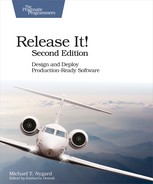The Principle of Least Privilege
The principle of “least privilege” mandates that a process should have the lowest level of privilege needed to accomplish its task. This never includes running as root (UNIX/Linux) or administrator (Windows). Anything application services need to do, they should do as nonadministrative users.
I’ve seen Windows servers left logged in as administrator for weeks at a time—with remote desktop access—because some ancient piece of vendor software required it. (This particular package also was not able to run as a Windows service, so it was essentially just a Windows desktop application left running for a long time. That is not production ready!)
Software that runs as root is automatically a target. Any vulnerability in root-level software automatically becomes a critical issue. Once an attacker has cracked the shell to get root access, the only way to be sure the server is safe is to reformat and reinstall.
To further contain vulnerabilities, each major application should have its own user. The “Apache” user shouldn’t have any access to the “Postgres” user, for example.
Opening a socket on a port below 1024 is the only thing that a UNIX application might require root privilege for. Web servers often want to open port 80 by default. But a web server sitting behind a load balancer (see Load Balancing) can use any port.
Containers and Least Privilege
Containers provide a nice degree of isolation from each other. Instead of creating multiple application-specific users on the host operating system, you can package each application into its own container. Then the host kernel will keep the containerized applications out of each others’ filesystems. That’s helpful for reducing the containers’ level of privilege.
Be careful, though. People often start with a container image that includes most of an operating system. Some containerized applications run a whole init system inside the container, allowing multiple shells and processes. At that point, the container has its own fairly large attack surface. It must be secured. Sadly, patch management tools don’t know how to deal with containers right now. As a result, a containerized application may still have operating system vulnerabilities that IT patched days or weeks ago.
The solution is to treat container images as perishable goods. You need an automated build process that creates new images from an upstream base and your local application code. Ideally this comes from your continuous integration pipeline. Be sure to configure timed builds for any application that isn’t still under active development, though.
